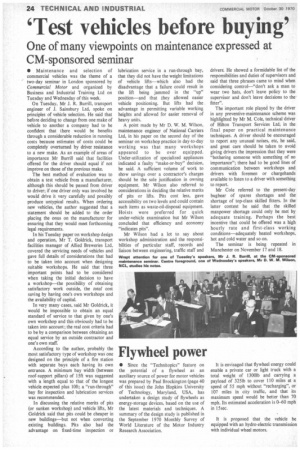'Test vehicles before buying'
Page 26

If you've noticed an error in this article please click here to report it so we can fix it.
One of many viewpoints on maintenance expressed at CM-sponsored seminar
• Maintenance and selection of commercial vehicles was the theme of a two-day seminar in London sponsored by Commercial Motor and organized by Business and Industrial Training Ltd on Tuesday and Wednesday of this week.
On Tuesday, Mr J. R. Burrill, transport engineer of J. Sainsbury Ltd, spoke on principles of vehicle selection. He said that before deciding to change from one make of vehicle to another a company had to be confident that there would be benefits through a considerable reduction in running costs because estimates of costs could be completely overturned by driver resistance to a new make. As an example of areas of importance Mr Burrill said that facilities offered for the driver should equal if not improve on those of the previous make.
The best method of evaluation was to obtain a test vehicle from a manufacturer, although this should be passed from driver to driver; if one driver only was involved he would drive it very carefully and possibly produce untypical results. When ordering new vehicles, the author suggested that a statement should be added to the order placing the onus on the manufacturer for ensuring that they would meet forthcoming legal requirements.
In his Tuesday paper on workshop design and operation, Mr T. Goldrick, transport facilities manager of Allied Breweries Ltd, covered the servicing needs of vehicles and gave full details of considerations that had to be taken into account when designing suitable workshops. He said that three important points had to be considered when taking the initial decision to have a workshop—the possibility of obtaining satisfactory work outside, the total cost saving by having one's own workshops and the availability of capital.
In very many cases, said Mr Goldrick, it would be impossible to obtain an equal standard of' service to that given by one's own workshop and this obviously had to be taken into account; the real cost criteria had to be by a comparison between obtaining an equal service by an outside contractor and one's own staff.
According to the author, probably the most satisfactory type of workshop was one designed on the principle of a fire station with separate bays each having its own entrance. A minimum bay width (between roof-support pillars) of 15ft was suggested with a length equal to that of the longest vehicle expected plus 10ft; a "run-through" bay for inspection and lubrication services was recommended.
In discussing the relative merits of pits (or sunken workshop) and vehicle lifts, Mr Goldrick said that pits could be cheaper in new buildings—but not when converting existing buildings. Pits also had the advantage on fixed-time inspection or lubrication service in a run-through bay, that they did not have the weight limitations of vehicle lifts--which also had the disadvantage that a failure could result in the lift being jammed in the "up" position—and that they allowed easier vehicle positioning. But lifts had the advantage in permitting variable working heights and allowed for easier removal of heavy units.
A point made by Mr D. W. M. Wilson, maintenance engineer of National Carriers Ltd, in his paper on the second day of the seminar on workshop practice in day-to-day working was that many workshops appeared to be over equipped. Under-utilization of specialized appliances indicated a faulty "make-or-buy" decision, he said. A sufficient volume of work to show savings over a contractor's charges should be the sole justification in owning equipment. Mr Wilson also referred to considerations in deciding the relative merits of pits or lifts. Pits cost less, gave accessibility on two levels and could contain such items as waste-oil-disposal equipment. Hoists were preferred for quick under-vehicle examination but Mr Wilson concluded that efficiency and economy "indicates pits".
Mr Wilson had a lot to say about workshop administration and the responsibilities of particular staff, records and liaison between engineering, traffic staff and drivers. He showed a formidable list of the responsibilities and duties of supervisors and said that three phrases came to mind when considering control—"don't ask a man to wear two hats, don't leave policy to the supervisor and don't leave decisions to the fitter".
The important role played by the driver in any preventive-maintenance scheme was highlighted by Mr M. Cole, technical driver of Hilton Transport Services Ltd, in the final paper on practical maintenance techniques. A driver should be encouraged to report any unusual noises, etc, he said, and great care should be taken to avoid giving drivers the impression that they were "bothering someone with something of no importance"; there had to be good lines of communication between workshops and drivers with foremen or chargehands available to listen to a driver with something to report.
Mr Cole referred to the present-day bugbear of spares shortages and the shortage of top-class skilled fitters. In the latter context he said that the skilled manpower shortage could only be met by adequate training. Perhaps the best incentive that could be offered was a high hourly rate and first-class working conditions—adequately heated workshops, hot and cold water and so on.
The seminar is being repeated in Manchester on November 17 and 18.








































































































